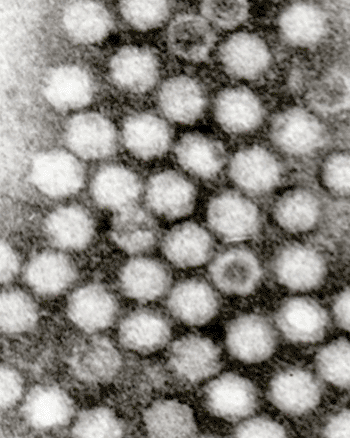Computer Models Help to Develop Improved Gene Therapy Vectors
By LabMedica International staff writers
Posted on 29 Aug 2013
Investigators in the field of gene therapy have used an advanced computer algorithm to predict how different adeno-associated viruses (AAVs) can be combined to form the optimum carriers of therapeutic genetic material.Posted on 29 Aug 2013
AAVs are small viruses that infect humans and some other primate species. AAVs are not currently known to cause disease, and the virus induces a very mild immune response. Gene therapy vectors using AAV can infect both dividing and quiescent cells and persist in an extrachromosomal state without integrating into the genome of the host cell. These features make AAV an attractive candidate for creating viral vectors for gene therapy.

Image: Electron micrograph of adeno-associated viruses (AAVs) (Photo courtesy of Dr. Graham Beards at en.wikipedia).
To develop quantitative design principles for guiding site-directed recombination of AAV capsids, investigators at Rice University (Houston, TX, USA) examined how capsid structural perturbations predicted by the SCHEMA algorithm correlated with experimental measurements of disruption in 17 chimeric capsid proteins.
They reported in the July 31, 2013, online addition of journal ACS Synthetic Biology that in a chimera population created by recombining AAV serotypes two and four, protection of viral genomes and cellular transduction were inversely related to calculated disruption of the capsid structure. The investigators did not observe a correlation between genome packaging and calculated structural disruption; a majority of the chimeric capsid proteins formed at least partially assembled capsids and more than half-packaged genomes, including those with the highest SCHEMA disruption. Thus, the SCHEMA algorithm should be useful for delineating quantitative design principles to guide the creation of libraries enriched in genome-protecting virus nanoparticles that can effectively transduce cells.
“Gene therapy shows promise in the treatment of not only genetic disorders but also cancer and cardiovascular diseases,” said senior author Dr. Junghae Suh, assistant professor of bioengineering at Rice University. “But you need a mechanism to get the correct gene into the human body and to the target cells. To do that, people use gene vectors, and viruses encompass the largest category of vectors. They have naturally evolved to deliver genes into the body. Our goal is to reprogram them to target specific organs or tissues.”
“The big challenge is to go about this in a rational manner,” said Dr. Suh. “People have done a lot of work to solve the structure of viruses. We know what they look like. The question is: How can we use that information to guide the design of our viral vectors?”
Related Links:
Rice University














